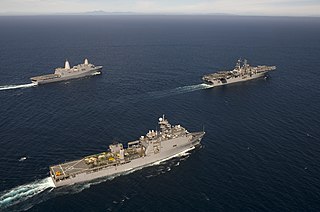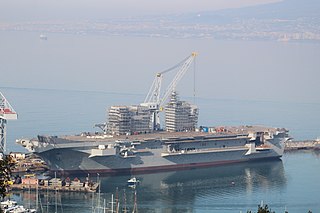
An amphibious transport dock, also called a landing platform dock (LPD), is an amphibious warfare ship, a warship that embarks, transports, and lands elements of a landing force for expeditionary warfare missions. Several navies currently operate this kind of ship. The ships are generally designed to transport troops into a war zone by sea, primarily using landing craft, although invariably they also have the capability to operate transport helicopters.

Landing craft are small and medium seagoing watercraft, such as boats and barges, used to convey a landing force from the sea to the shore during an amphibious assault. The term excludes landing ships, which are larger. Production of landing craft peaked during World War II, with a significant number of different designs produced in large quantities by the United Kingdom and United States.

A dock landing ship is an amphibious warfare ship with a well dock to transport and launch landing craft and amphibious vehicles. Some ships with well decks, such as the Soviet Ivan Rogov class, also have bow doors to enable them to deliver vehicles directly onto a beach. Modern dock landing ships also operate helicopters.

The Galicia class are two landing platform dock (LPD) ships in service with the Spanish Navy. Built by Navantia at Ferrol, their mission is to carry out amphibious warfare by transporting the bulk of the Infantería de Marina. These ships have both a large helicopter flight deck and a 885-square-metre (9,530 sq ft) well deck for large landing craft, as well as a 1,000-square-metre (11,000 sq ft) space for up to 33 main battle tanks.

The Ōsumi class (おおすみ型輸送艦), is a Japanese tank landing ship. The class is also known as the Oosumi class. While the Japan Maritime Self-Defense Force (JMSDF) describes the Ōsumi class as tank landing ships (LSTs), they lack the bow doors and beaching capability traditionally associated with LSTs. Functionally, their well deck makes the Ōsumi class more like a dock landing ship (LSD).

Juan Carlos I is a multi-purpose aircraft carrier-landing helicopter dock (LHD) in the Spanish Navy. Similar in role to many aircraft carriers, the amphibious landing ship has a ski jump for STOVL operations, and is equipped with the McDonnell Douglas AV-8B Harrier II attack aircraft. The vessel is named in honour of Juan Carlos I, the former king of Spain.

Newport-class tank landing ships were an improved class of tank landing ship (LST) designed for and employed by the United States Navy from 1969 to 2002. The ships were intended to provide substantial advantages over their World War II-era predecessors. Larger and faster than any previous LST design, they carried a ramp over the bow that allowed them to surpass 20 knots, a goal of the United States amphibious forces. 27 were planned of which twenty were completed, the high number due to the demands of US force projection estimates. However, the arrival of the air-cushioned landing craft which allowed for over-the-horizon attacks made the class obsolete in the eyes of the United States Navy. Placed in reserve, twelve were eventually sold to foreign navies, while the remaining eight have since been decommissioned.
A joint support ship (JSS) is a multi-role naval vessel capable of launching and supporting joint amphibious and airlift operations. It can also provide command and control, sealift and seabasing, underway replenishment, disaster relief and logistics capabilities for combined land and sea operations.

The Type 071 is a class of Chinese amphibious transport dock ships in service with the People's Liberation Army Navy (PLAN). The Type 071 provides the PLAN with capabilities and flexibility not found in its previous landing ships.

The San Giorgio class are amphibious transport docks (LPD) built by Fincantieri for the Italian Navy. These ships can carry a battalion of troops, and up to 36 armored vehicles. The stern floodable dock can accommodate three landing craft. The ships are based at the Brindisi naval base on the Adriatic coast.

An amphibious assault ship is a type of warship employed to land and support ground forces on enemy territory during an armed conflict. The design evolved from aircraft carriers converted for use as helicopter carriers. Modern designs support amphibious landing craft, with most designs including a well deck. Like the aircraft carriers they were developed from, some amphibious assault ships also support V/STOL fixed-wing aircraft and have a secondary role as aircraft carriers.

An amphibious warfare ship is an amphibious vehicle warship employed to land and support ground forces, such as marines, on enemy territory during an amphibious assault.

The LHD Trieste is a multi-purpose aircraft carrier-landing helicopter dock (LHD) of the Italian Navy. The ship replaced the aircraft carrier Giuseppe Garibaldi and is the largest vessel in the Italian fleet. It was ordered as part of the 2014–2015 naval program and was built at the Castellammare di Stabia shipyards of Fincantieri. On 7 December 2024, the ship was commissioned at the Italian Navy's base in Livorno.

The Type 075 landing helicopter dock is a class of Chinese amphibious assault ships built by Hudong–Zhonghua Shipbuilding for the People's Liberation Army Navy (PLAN). It has a full-length flight deck for helicopter operations and features a floodable well deck from which to disembark hovercraft and armored amphibious assault vehicles.

The Type 726 LCAC, also known as the Wild Horse class LCAC(Chinese: 野马型气垫船) is a class of air-cushioned landing craft used by the People's Liberation Army Navy. Six Yuyi-class LCACs are believed to be in service with the People’s Liberation Army (PLA), with the first one (3320) being seen at the end of 2007. It is thought that the vessels were delivered in two batches, with the first three LCACs reportedly powered by Ukrainian UGT 6000 engines, while the other subsequent production models are believed to use indigenous QC-70 gas turbines. Up to four Yuyi-class LCACs can be carried in the well deck of the Yuzhao-class landing platform dock (LPD) and Yushen-class landing helicopter dock (LHD).
Multi-Role Support Ship (MRSS) is a class of amphibious ship planned for the Royal Malaysian Navy (RMN).

Changbai Shan (989) is a Type 071 amphibious transport dock of the People's Liberation Army Navy.

Hainan (31) is the lead ship of the Type 075 landing helicopter dock of the People's Liberation Army Navy. She was commissioned on 23 April 2021.
The Multi-Role Support Ship (MRSS) is a planned class of up to six multi-mission amphibious warfare ships in development for the United Kingdom's Royal Navy. The ships were first officially mentioned in the British government's 2021 defence white paper, titled Defence in a Competitive Age. In May 2024, funding for the ships was announced at the Sea Power Conference in London. They will replace the service's two Albion-class landing platform docks, three Bay-class landing ship docks and the multi-purpose support ship RFA Argus.














